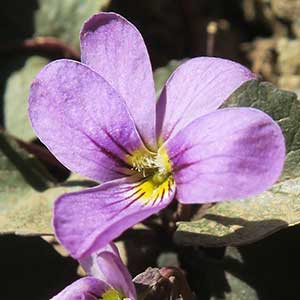Viola flettii
Viola langsdorffii
Flett's violet, Olympic violet, rock violet
Alaska violet, Aleutian violet, Langsdorff's violet, violette de Langsdorff
1–3, ascending to erect, mostly glabrous, on caudex from fleshy rhizome.
1–3, ascending to erect, usually glabrous, from shallow, fleshy rhizome.
basal and cauline;
basal: 1–3;
stipules linear-lanceolate, margins entire or with glandular processes, apex acuminate;
petiole 1.5–9.7 cm, mostly glabrous;
blade purple-tinted and –veined, broadly reniform to ovate, 0.9–2.4 × 1.2–4 cm, base cordate, margins finely crenate-serrate, eciliate, apex acute to obtuse, surfaces glabrous or sparsely pubescent along veins adaxially;
cauline similar to basal except: stipules ovate to lanceolate, margins entire or shallowly laciniate;
petiole 0.7–5.9 cm, usually glabrous;
blade 0.8–2.1 × 1.2–3.1 cm.
basal and cauline;
basal: 2–3;
stipules broadly ovate to deltate or long-lanceolate, margins often glandular (glands sessile or stalked), apex acute;
petiole 0.8–21 cm, glabrous or sparsely pubescent;
blade ovate to reniform, 0.9–5.8 × 1–6 cm, base cordate to ± truncate, margins crenate to crenate-serrulate, usually eciliate, apex rounded or acute to usually obtuse, surfaces glabrous or sparsely pubescent on adaxial veins, seldom on abaxial veins;
cauline similar to basal except: stipules broadly ovate to lanceolate-oblong or deltate, apex acute to acuminate;
petiole 2.2–12.1 cm;
blade 1.9–4.2 × 1.8–5.9 cm.
1.8–7.1 cm, usually glabrous.
2.2–20.7 cm, glabrous or sparsely pubescent.
sepals lanceolate, margins eciliate, auricles 0.5–1.5 mm;
petals soft reddish violet on both surfaces, all with yellow area basally, lower 3 dark violet-veined, lateral 2 bearded, lowest with white around yellow area, 10–15 mm, spur yellow, gibbous, 0.5–2 mm;
style head bearded; cleistogamous flowers axillary.
sepals lanceolate to ovate, margins eciliate, auricles 0.5–1.5 mm;
petals light to deep violet on both surfaces, lower 3 white basally and light to deep violet-veined, lateral 2 bearded, lowest 12–24 mm, spur white to violet, gibbous to elongated, 2–5 mm, usually less than 1/2 lowest petal, tip straight;
style head usually beardless, sometimes bearded; cleistogamous flowers axillary.
± spherical, 5–9 mm, glabrous.
ovoid to oblong, 7.5–13 mm, glabrous.
dark brown to brownish purple, 2.5–3 mm.
dark olive to ± black, 2.5–2.8 mm.
= 12.
Viola flettii
Viola langsdorffii
Viola flettii is endemic to the Olympic Mountains of northwestern Washington. C. S. McCreary (2005) noted that although morphologically and ecologically distinct, V. cuneata, V. flettii, and V. ocellata are closely related.
(Discussion copyrighted by Flora of North America; reprinted with permission.)
Viola simulata and V. superba are closely related to V. langsdorffii (L. Abrams and R. S. Ferris 1923–1960, vol. 3). They were treated by C. L. Hitchcock et al. (1955–1969, vol. 3) as synonymous with V. langsdorffii pending further study.
E. Brainerd (1921) stated that Viola langsdorffii presents an interesting transition between the caulescent and acaulescent violets. Plants of the species are reported from Winchester Grade in Idaho (Gail s.n., 1931, ID); verification is needed. Viola langsdorffii is reported to have fleshy rhizomes. Plants in Del Norte County, California, have fleshy rhizomes near the soil surface, but these are connected to deeper, subligneous rhizomes.
The style in some populations of Viola langsdorffii is reported to be sometimes bearded (G. W. Douglas et al. 1998–2002, vol. 5; W. J. Cody 2000). Illustrations in V. B. Baird (1942; location of plant unknown) and M. S. Baker (1936; a plant from Alaska) show a beardless style; L. Abrams and R. S. Ferris (1923–1960, vol. 3) and C. L. Hitchcock et al. (1955–1969, vol. 3) reported that the style head was beardless. Styles are beardless in plants occurring in Del Norte County, California.
(Discussion copyrighted by Flora of North America; reprinted with permission.)
- Local floras:
BC,
CA,
OR,
WA
- Local Web sites:
CalFlora,
CalPhotos,
Flora NW,
PNW Herbaria
WildflowerSearch
iNaturalist (observations)
USDA Plants Database
- LBJ Wildflower Center
- SEINet
- Plants of the World Online
- Encyclopedia of Life
- Wikipedia
- Google Image Search


